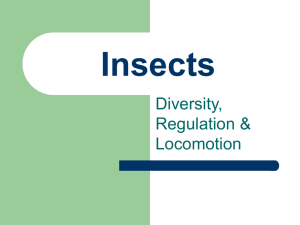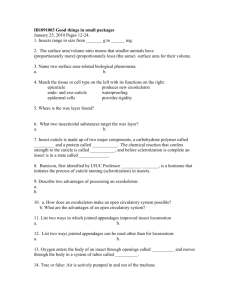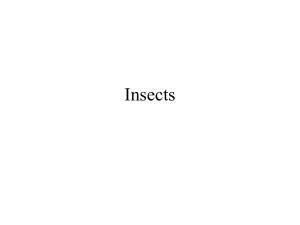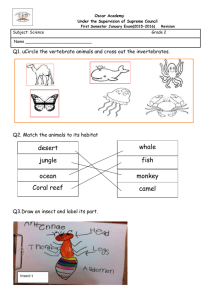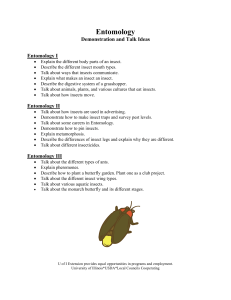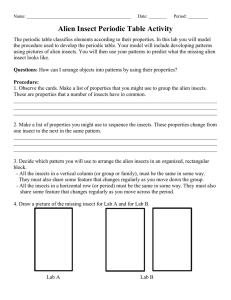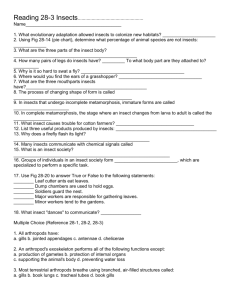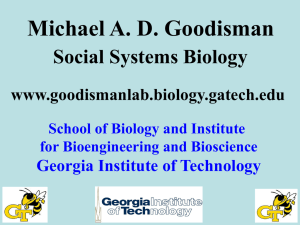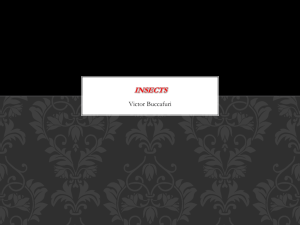BIOLOGY AND DIVERSITY OF INSECTS
advertisement
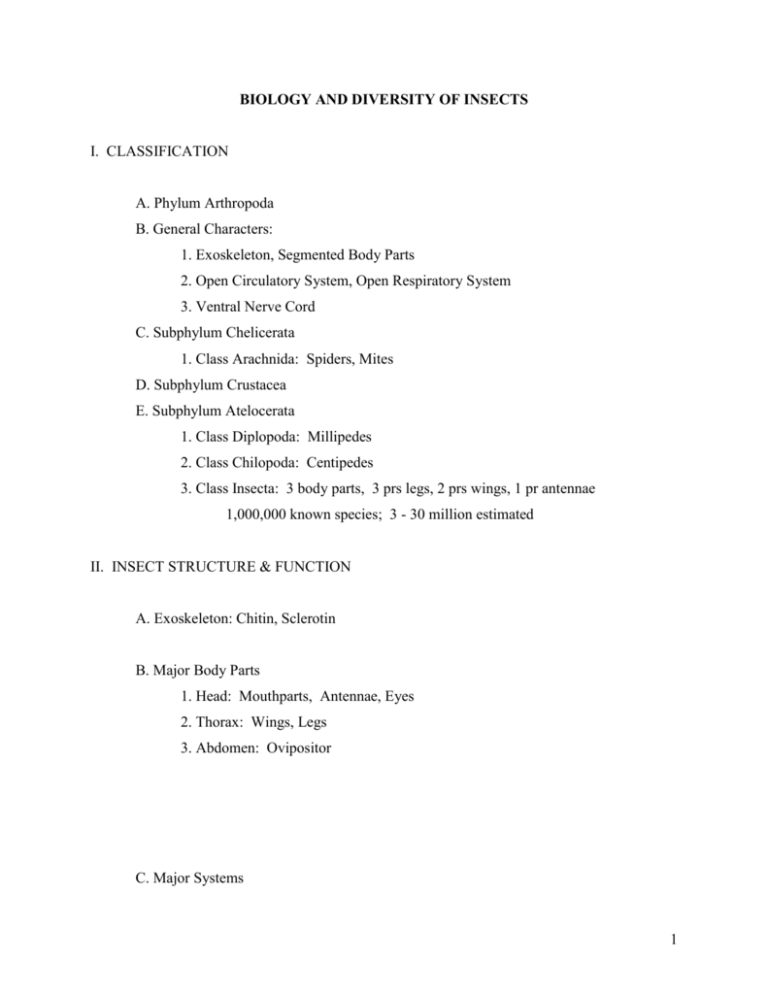
BIOLOGY AND DIVERSITY OF INSECTS I. CLASSIFICATION A. Phylum Arthropoda B. General Characters: 1. Exoskeleton, Segmented Body Parts 2. Open Circulatory System, Open Respiratory System 3. Ventral Nerve Cord C. Subphylum Chelicerata 1. Class Arachnida: Spiders, Mites D. Subphylum Crustacea E. Subphylum Atelocerata 1. Class Diplopoda: Millipedes 2. Class Chilopoda: Centipedes 3. Class Insecta: 3 body parts, 3 prs legs, 2 prs wings, 1 pr antennae 1,000,000 known species; 3 - 30 million estimated II. INSECT STRUCTURE & FUNCTION A. Exoskeleton: Chitin, Sclerotin B. Major Body Parts 1. Head: Mouthparts, Antennae, Eyes 2. Thorax: Wings, Legs 3. Abdomen: Ovipositor C. Major Systems 1 1. Nervous 2. Circulatory 3. Respiratory 4. Digestive 5. Reproductive III. GROWTH & DEVELOPMENT A. Moulting 1. Hormonal regulation: Ecdysone B. Development 1. Types a. Hemimetabolous b. Holometabolous 2. Hormonal Control: Juvenile Hormone C. Parthenogenesis, Vivipary D. Diapause (obligate, facultative), Estivation, Migration IV. MAJOR INSECT ORDERS A. Orthoptera: Crickets, Grasshoppers B. Phasmatodea: Stick Insects C. Blattodea: Roaches D. Blattodea (Isoptera): Termites E. Mantodea: Mantids F. Thysanoptera: Thrips 2 G. Hemiptera: Bugs, Aphids, Scales 1. Heteroptera: Bugs 2. Homoptera: Leaf hoppers, Plant hoppers Aphids, scale insects H. Coleoptera: Beetles I. Lepidoptera: Butterflies & Moths J. Diptera: Flies K. Hymenoptera: Wasps, Bees, Ants, Parasitic Wasps, Sawflies V. BEHAVIOR A. Orientation: Neuromuscular Sequences, Kineses; Modalities & Organs of Perception, Modulation by Internal & External Cues B. Feeding 1. Host range: Monophagy, Oligophagy, Polyphagy C. Reproduction 1. Mate Finding 2. Mating D. Oviposition 3 VI. INSECT POPULATION DYNAMICS A. Implications to Plant Insect Interactions 1. Coevolution: Selective Pressures on Plants 2. Natural Resource Management a. Pests b. Biodiversity, Endangered species c. Environmental indicators B. Characteristics of Populations 1. General 2. Insects a. High fecundity b. Short generation times c. Female - bias d. High death rates C. Population Processes (Role of Plant Suitability) 1. Birth 2. Death 3. Emigration 4. Immigration D. Population Models 1. Exponential growth 2. Sigmoid growth (carrying capacity) 3. Density independent and density dependent factors a. Competition b. Predation 4 1. Functional response: As prey population increases, number of prey eaten per predator increases due to improved prey-finding 2. Numerical response: As prey population increases, number of predators increases due to improved reproduction following time lag c. Disease d. Non lethal effects: Development time, Fecundity e. Allee effects: Inverse density-dependence at very low density 1. Due to difficulties in mate-finding, host utilization, escaping predators 2. Important in species extinction and establishment of invasive species E. Importance of time delays F. Variation within Populations 1. Phenotypic plasticity: Behavioral, physiological, and ecological variation among populations; BOTH genetic & env components a. Adaptive advantage to plasticity? b. Example: Maternal influence - Experience of parent influences offspring characters c. Examples of host plant effects on insect herbivores 2. Genetic Variation a. Different races may differentially utilize host plants 1. Protective coloration as an example 2. Larch budmoth b. Implications to natural resource issues 1. Agriculture 2. Plant Resistance Breeding 5 G. Nonequilibrium Behavior: Theories 1. Dramatic changes in environment 2. Changes in intrinsic genetic properties 3. Altered availability, suitability, susceptibility of plants 4. Escape from natural enemies 5. Features of life history 6
